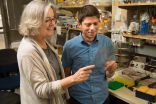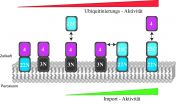(Press-News.org) September 22, 2014 – Available research evidence supports the use of deep brain stimulation (DBS) for patients with obsessive-compulsive disorder (OCD) who don't respond to other treatments, concludes a review in the October issue of Neurosurgery, official journal of the Congress of Neurological Surgeons (CNS). The journal is published by Lippincott Williams & Wilkins, a part of Wolters Kluwer Health.
Based on evidence, two specific bilateral DBS techniques are recommended for treatment of carefully selected patients with OCD, according to a new clinical practice guideline endorsed by the CNS and the American Association of Neurological Surgeons. While calling for further research in key areas, Dr. Clement Hamani of Toronto Western Hospital and coauthors emphasize that patients with OCD symptoms that don't respond to other treatments should continue to have access to DBS.
Deep Brain Stimulation for OCD—What's the Evidence?
Dr. Hamani led a multispecialty expert group in performing a systematic review of research on the effectiveness of DBS for OCD. Deep brain stimulation—placement of electrodes in specific areas of the brain, followed by electrical stimulation of those areas—has become an important treatment for patients with Parkinson's disease and other movement disorders.
Although many patients with OCD respond well to medications and/or psychotherapy, 40 to 60 percent continue to experience symptoms despite treatment. Over the past decade, a growing number of reports have suggested that DBS may be an effective alternative in these "medically refractory" cases.
Dr. Hamani and colleagues were tasked with analyzing the supporting evidence and developing an initial clinical practice guideline for the use of DBS for patients with OCD. The review and guideline development process was sponsored by the American Society of Stereotactic and Functional Neurosurgery and the CNS. Out of more than 350 papers, the reviewers identified seven high-quality studies evaluating DBS for OCD.
Based on that evidence, they conclude that bilateral stimulation (on both sides of the brain) of two brain "targets"—areas called the subthalamic nucleus and the nucleus accumbens—can be regarded as effective treatments for OCD. In controlled clinical trials, both techniques improved OCD symptoms by around 30 percent on a standard rating scale.
While Research Proceeds, well-selected treatment-resistant severe OCD Patients Should Have Access to DBS
That evidence forms the basis for a clinical guideline stating that bilateral DBS is a "reasonable therapeutic option" for patients with severe OCD that does not respond to other treatments. The guideline also notes that there is "insufficient evidence" supporting the use of any type of unilateral DBS target (one side of the brain) for OCD.
The review highlights the difficulties of studying the effectiveness of DBS for OCD—because most patients respond to medical treatment, studies of this highly specialized treatment typically include only small numbers of patients. Dr. Hamani and coauthors identify some priorities for future research: particularly to identify the most effective brain targets and the subgroups of patients most likely to benefit.
Despite the limited evidence base, DBS therapy for OCD has been approved by the Food and Drug Administration under a humanitarian device exemption. Dr. Hamani and coauthors note that various safeguards are in place to ensure appropriate use, and prevent overuse, of DBS for OCD.
While research continues, they believe that functional neurosurgeons should continue to work with other specialists to ensure that patients with severe, medically refractory OCD continue to have access to potentially beneficial DBS therapy.
INFORMATION:
Click here to read "Deep Brain Stimulation for Obsessive-Compulsive Disorder: Systematic Review and Evidence-Based Guideline Sponsored by the American Society for Stereotactic and Functional Neurosurgery and the Congress of Neurological Surgeons (CNS) and Endorsed by the CNS and American Association of Neurological Surgeons."
About Neurosurgery
Neurosurgery, the Official Journal of the Congress of Neurological Surgeons, is your most complete window to the contemporary field of neurosurgery. Members of the Congress and non-member subscribers receive 3,000 pages per year packed with the very latest science, technology, and medicine, not to mention full-text online access to the world's most complete, up-to-the-minute neurosurgery resource. For professionals aware of the rapid pace of developments in the field, Neurosurgery is nothing short of indispensable.
About Wolters Kluwer Health
Wolters Kluwer Health is a leading global provider of information, business intelligence and point-of-care solutions for the healthcare industry. Serving more than 150 countries worldwide, clinicians rely on Wolters Kluwer Health's market leading information-enabled tools and software solutions throughout their professional careers from training to research to practice. Major brands include Health Language®, Lexicomp®, Lippincott Williams & Wilkins, Medicom®, Medknow, Ovid®, Pharmacy OneSource®, ProVation® Medical and UpToDate®.
Wolters Kluwer Health is part of Wolters Kluwer, a market-leading global information services company. Wolters Kluwer had 2013 annual revenues of €3.6 billion ($4.7 billion), employs approximately 19,000 people worldwide, and maintains operations in over 40 countries across Europe, North America, Asia Pacific, and Latin America.maintains operations in over 40 countries across Europe, North America, Asia Pacific, and Latin America. Wolters Kluwer is headquartered in Alphen aan den Rijn, the Netherlands. Its shares are quoted on Euronext Amsterdam (WKL) and are included in the AEX and Euronext 100 indices. Wolters Kluwer has a sponsored Level 1 American Depositary Receipt program. The ADRs are traded on the over-the-counter market in the U.S. (WTKWY).
Follow our official Twitter handle: @WKHealth.
Evidence supports deep brain stimulation for obsessive-compulsive disorder
Bilateral stimulation is effective for OCD that doesn't respond to medications, says new guideline in Neurosurgery
2014-09-22
ELSE PRESS RELEASES FROM THIS DATE:
Involving female offenders in release planning can increase reintegration success
2014-09-22
TORONTO, Sept, 22, 2014--Women who are about to be released from prison need to be more involved in their discharge planning if they are to successfully reintegrate into their communities and avoid returning to prison, according to a new study.
Almost half of all female prisoners are back behind bars within one year of their release and most have multiple prison terms, mainly for drug-related offenses.
Dr. Flora Matheson, a researcher at St. Michael's Hospital, conducted one-on-one interviews with women who were about to be released or had been recently released from ...
Scientists discover an on-off switch for aging cells
2014-09-22
La Jolla -- Scientists at the Salk Institute have discovered an on-and-off "switch" in cells that may hold the key to healthy aging. This switch points to a way to encourage healthy cells to keep dividing and generating, for example, new lung or liver tissue, even in old age.
In our bodies, newly divided cells constantly replenish lungs, skin, liver and other organs. However, most human cells cannot divide indefinitely–with each division, a cellular timekeeper at the ends of chromosomes shortens. When this timekeeper, called a telomere, becomes too short, cells can no ...
Where is that spacecraft?
2014-09-22
Philadelphia, PA—Space surveillance is inherently challenging when compared to other tracking environments due to various reasons, not least of which is the long time gap between surveillance updates. "Unlike the air and missile defense environments where objects are frequently observed, the space surveillance environment data is starved, with many objects going several orbital periods between observations," according to researcher Joshua Horwood. "Thus, it is more challenging to predict the future location of these sparsely-seen objects and they have a tendency to get ...
Neurosurgery tackles past, current and future concepts of sports concussion
2014-09-22
September 22, 2014 - An estimated 1.68 to 3.8 million sports-related concussions occur in the United States each year, and there are likely a significant number that go unreported. Current Concepts in Sports Concussion is a comprehensive, 16-article supplement of Neurosurgery, official journal of the Congress of Neurological Surgeons. Chicago-area neurosurgeon Gail Rosseau, MD, the lead guest editor, is well known for her longtime commitment to sports-related head injury prevention, and serves on the Board of Directors of USA Football and ThinkFirst. Additional guest editors ...
Comprehensive Neurosurgery supplement covers sports-related concussions
2014-09-22
September 22, 2014 - Neurosurgeons have treated head and spinal sports injuries since the specialty was formed in the early 20th century, with formal efforts to mitigate these injuries dating back to 1931. Current Concepts in Sports Concussion is a comprehensive, 16-article supplement of Neurosurgery, official journal of the Congress of Neurological Surgeons, published by Lippincott Williams & Wilkins, part of Wolters Kluwer Health. The supplement includes a detailed, fascinating history of concussion treatment and research. The lead guest editor is Chicago-area neurosurgeon ...
Communication without detours
2014-09-22
Certain nerve cells take a shortcut for the transmission of information: signals are not conducted via the cell`s center, but around it like on a bypass road. The previously unknown nerve cell shape is now presented in the journal "Neuron" by a research team from Heidelberg, Mannheim and Bonn.
Nerve cells communicate by using electrical signals. Via widely ramified cell structures—the dendrites—, they receive signals from other neurons and then transmit them over a thin cell extension—the axon—to other nerve cells. Axon and dendrites are usually interconnected by the ...
The accelerator of molecular motors
2014-09-22
To their surprise, it turned out to be an old acquaintance: a certain module of the familiar protein Pex22p, which has hitherto always been considered an anchor protein. The researchers report their findings in PLoS One.
Essential: importing enzymes into peroxisome
Peroxisomes are of vital importance for the enzymatic degradation of long-chain fatty acids and cellular toxins. In order for them to fulfil this function, the relevant enzymes have to be imported into the peroxisomes first. The bulk is brought into a peroxisome by the import receptor Pex5p. That receptor, ...
Why do leaves change color in the fall? (video)
2014-09-22
WASHINGTON, Sept. 22, 2014 — It's the first day of autumn, and the telltale signs are here: crisp weather, pumpkin spice lattes and, most importantly, the leaves are changing colors. Ever wonder why some leaves turn red, others yellow and some just turn brown? We'll tell you all about the chemistry behind this seasonal spectacle in the latest Reactions episode. Learn all about it at https://www.youtube.com/watch?v=X0nWmTeQPfo.
Subscribe to the series at Reactions YouTube, and follow us on Twitter @ACSreactions to be the first to see our latest videos.
INFORMATION:The ...
Finding hints of gravitational waves in the stars
2014-09-22
Scientists have shown how gravitational waves—invisible ripples in the fabric of space and time that propagate through the universe—might be "seen" by looking at the stars. The new model proposes that a star that oscillates at the same frequency as a gravitational wave will absorb energy from that wave and brighten, an overlooked prediction of Einstein's 1916 theory of general relativity. The study, which was published today in the Monthly Notices of the Royal Astronomical Society: Letters, contradicts previous assumptions about the behavior of gravitational waves.
"It's ...
New study finds 34 percent of severely injured patients undertriaged in the United States
2014-09-22
According to the American College of Surgeons' Committee on Trauma, patients with severe injuries should be treated at level I or level II trauma centers. Those centers have the resources to provide the best care for those patients.
But 1 out of 3 major trauma patients in 2010 actually received their treatment at lower-level trauma centers or nontrauma centers, according to a new study from the Center for Pediatric Trauma Research and the Center for Injury Research and Policy at Nationwide Children's Hospital. Those patients are "undertriaged." The ACS' Committee on Trauma ...
LAST 30 PRESS RELEASES:
Making lighter work of calculating fluid and heat flow
Normalizing blood sugar can halve heart attack risk
Lowering blood sugar cuts heart attack risk in people with prediabetes
Study links genetic variants to risk of blinding eye disease in premature infants
Non-opioid ‘pain sponge’ therapy halts cartilage degeneration and relieves chronic pain
AI can pick up cultural values by mimicking how kids learn
China’s ecological redlines offer fast track to 30 x 30 global conservation goal
Invisible indoor threats: emerging household contaminants and their growing risks to human health
Adding antibody treatment to chemo boosts outcomes for children with rare cancer
Germline pathogenic variants among women without a history of breast cancer
Tanning beds triple melanoma risk, potentially causing broad DNA damage
Unique bond identified as key to viral infection speed
Indoor tanning makes youthful skin much older on a genetic level
Mouse model sheds new light on the causes and potential solutions to human GI problems linked to muscular dystrophy
The Journal of Nuclear Medicine ahead-of-print tip sheet: December 12, 2025
Smarter tools for peering into the microscopic world
Applications open for funding to conduct research in the Kinsey Institute archives
Global measure underestimates the severity of food insecurity
Child survivors of critical illness are missing out on timely follow up care
Risk-based vs annual breast cancer screening / the WISDOM randomized clinical trial
University of Toronto launches Electric Vehicle Innovation Ontario to accelerate advanced EV technologies and build Canada’s innovation advantage
Early relapse predicts poor outcomes in aggressive blood cancer
American College of Lifestyle Medicine applauds two CMS models aligned with lifestyle medicine practice and reimbursement
Clinical trial finds cannabis use not a barrier to quitting nicotine vaping
Supplemental nutrition assistance program policies and food insecurity
Switching immune cells to “night mode” could limit damage after a heart attack, study suggests
URI-based Global RIghts Project report spotlights continued troubling trends in worldwide inhumane treatment
Neutrophils are less aggressive at night, explaining why nighttime heart attacks cause less damage than daytime events
Menopausal hormone therapy may not pose breast cancer risk for women with BRCA mutations
Mobile health tool may improve quality of life for adolescent and young adult breast cancer survivors
[Press-News.org] Evidence supports deep brain stimulation for obsessive-compulsive disorderBilateral stimulation is effective for OCD that doesn't respond to medications, says new guideline in Neurosurgery




